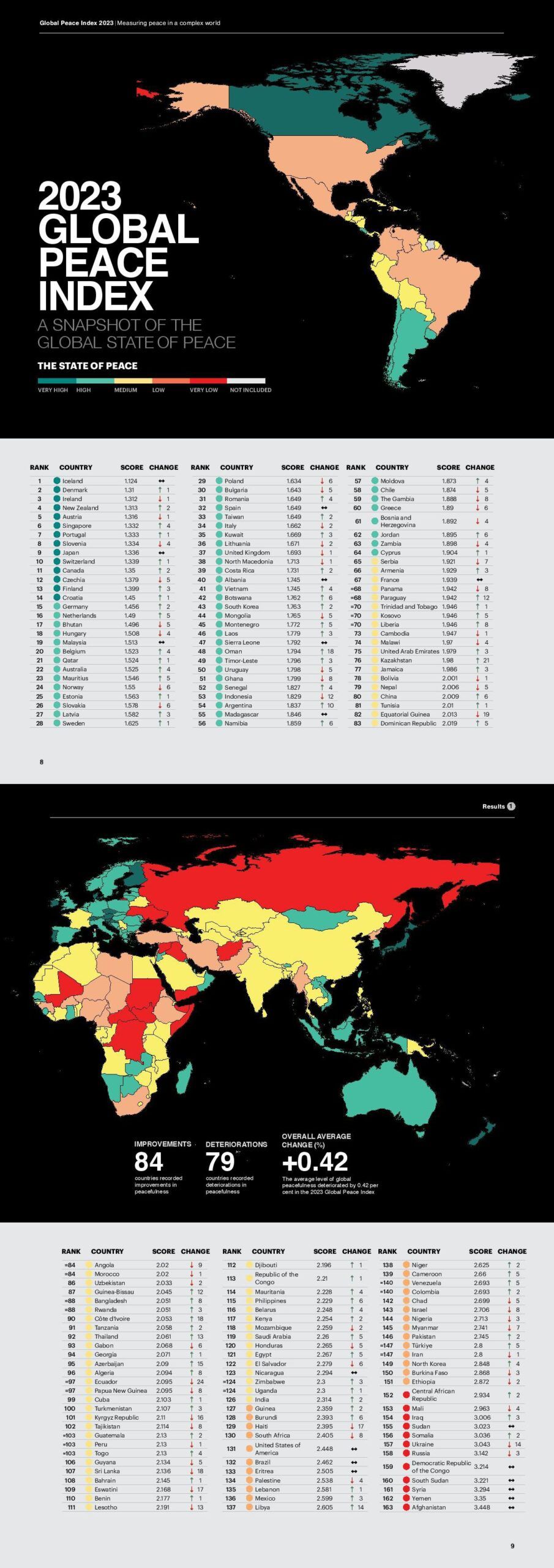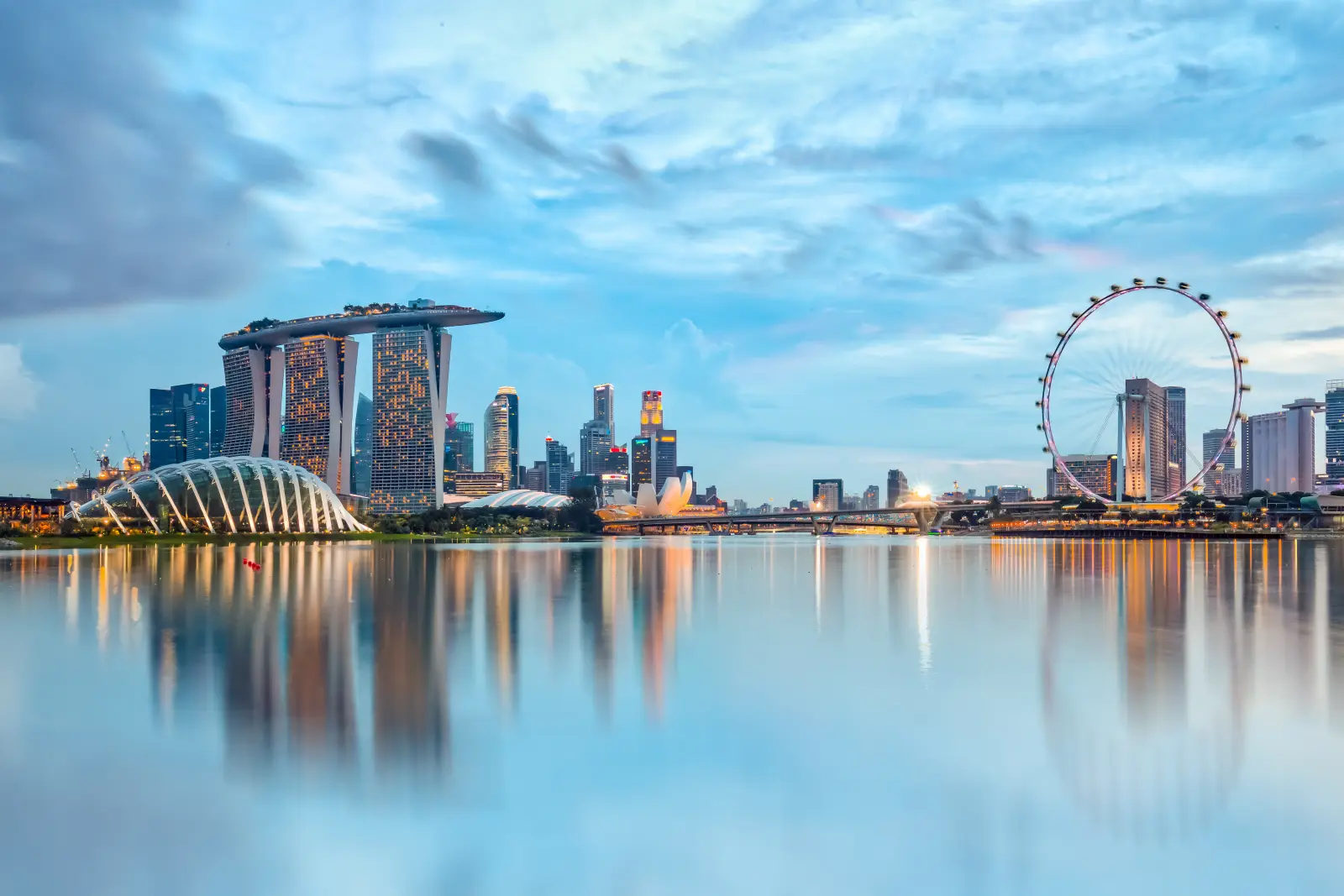Amid rising global conflicts, the “World’s Most Peaceful Countries in 2023” report by the Institute for Economics and Peace offers an in-depth look at global peace levels. The 2023 GPI report highlights the world’s most tranquil nations and delves into the elements that foster their peace amidst increasing geopolitical tensions.
Declining Global Peacefulness
The GPI 2023 report underscores a concerning trend: a 0.42 percent decline in the average level of global peacefulness, marking the ninth consecutive year of this downturn. The primary catalyst for this decline was Russia’s invasion of Ukraine, significantly affecting global peace levels. As a result, both Russia and Ukraine rank among the ten least peaceful countries in 2023.
The 2023 GPI finds that the world became less peaceful for the 13th time in the last 15 years, with the average level of country peacefulness deteriorating by 0.42 percent over the past year.
The deterioration in peacefulness was mainly due to a deterioration in the Ongoing Conflict domain. Deaths from internal conflict, neighboring countries relations, and external conflicts fought all recorded significant deteriorations, with the total number of conflict-related deaths increasing by 96 percent. Although the conflict in Ukraine was the primary driver of this increase, increases in conflict were also seen in many other countries, particularly in sub-Saharan Africa and the Asia-Pacific.
There was a slight deterioration in the Safety and Security domain, with the largest deterioration occurring in the political instability indicator. 59 countries recorded a deterioration in political instability in 2022. However, the terrorism impact indicator improved for the fourth consecutive year, with 70 countries recording lower levels of terrorism in 2022, and only 28 recording a deterioration.
Militarisation was the only domain to record an improvement on the 2023 GPI. Of the 163 GPI countries, 109 recorded an improvement.
Europe’s Peacefulness Erodes
Despite Europe being the most peaceful region globally, it experienced a decline in all three GPI domains: societal safety and security, ongoing domestic and international conflict, and the degree of militarization. The tensions between European countries and Russia have led to Europe being less peaceful than it was 15 years ago.
Iceland remains the most peaceful country in the region and the world in the 2023 GPI. It has been the most peaceful country in the world for every year since the index began. However, Iceland recorded a four percent deterioration in its overall score as the result of an increase in the homicide rate and also the terrorism impact indicator. This is the first year that any terrorist activity has been recorded in the country. Four individuals were arrested and charged with plotting terrorist attacks against the Icelandic parliament and several prominent Icelandic politicians.
Türkiye remains the least peaceful country in the region and is the only European country ranked outside the top half of the index. The country experienced a 1.7 percent decrease in its overall score, which was led by deteriorations in the Ongoing Conflict and Safety and Security domains. This is the least peaceful Türkiye has been since the inception of the GPI in 2008. The deterioration in peacefulness was driven by the deaths from external conflict and the incarceration rate indicators, which rose 46.3 and 12.3 per cent respectively. Türkiye has also been one of the most active exporters of military technology in the past few years, particularly drones, which led to its weapons exports indicator deteriorating.
The Top 15 Most Peaceful Countries
In contrast, several countries have maintained high levels of peace. The GPI 2023 identifies the top 15 most peaceful countries, excelling in factors such as resource distribution, respect for rights, neighborly relations, and information flow. Here are the countries leading the list with their GPI scores:
- Iceland (1.124): Continues to top the list, exemplifying peace with its stable society and minimal internal and external conflicts.
- Denmark (1.31)
- Ireland (1.312)
- New Zealand (1.313)
- Austria (1.316)
- Singapore (1.332)
- Portugal (1.333)
- Slovenia (1.334)
- Japan (1.336)
- Switzerland (1.339)
- Canada (1.35)
- Czechia (1.379)
- Finland (1.399)
- Croatia (1.45)
- Germany (1.456)
These countries have managed to maintain internal and external peace, with their GPI scores reflecting a balance between societal safety, conflict absence, and limited militarization.
Global Trends and Regional Highlights
While 84 countries recorded an improvement in peacefulness, 79 experienced a decline. The MENA region, despite improvements, remains the least peaceful globally. Libya, Côte d’Ivoire, and Afghanistan are among the top five improvers in peace, highlighting significant recoveries from past conflicts. However, the increase in conflict-related deaths and political instability globally raises concerns.
Israel experienced the largest deterioration in peacefulness in the MENA region, falling eight places to 143rd in the GPI. Israel’s overall level of peacefulness has not been this low since 2010. There were two main drivers of this deterioration in peacefulness: a worsening of neighboring countries relations, especially with Palestine, and a sharp increase in political instability. Israel’s relationship with its neighbors was damaged by an increase in the intensity of the conflict between Israelis and Palestinians, with the terrorism impact and deaths from internal conflict indicators both deteriorating. Political instability deteriorated after mass political protests against attempts by the government to curb the power of the judiciary to limit or overturn government legislation.
Peacefulness in the United States
The United States experienced a slight deterioration in peacefulness over the past year, the continuation of a trend that began in 2015. Civil unrest is no longer the primary driver of the deterioration, as the violent demonstrations indicator improved by ten percent and political instability experienced no change. The deterioration was driven by a deterioration on the Safety and Security domain, particularly in the perceptions of criminality and homicide rate indicators. The United States recorded the fourth largest overall increase in its homicide rate, which is now above six per 100,000 people and more than six times higher than most Western European countries.
Conclusion
The GPI 2023 report is a stark reminder of the fluctuating state of global peace. While some regions continue to enjoy tranquility, others face growing challenges. The report serves as a call to action for world leaders to invest in peace-building and resilience strategies, emphasizing the need for concerted efforts to reverse negative trends and promote a more peaceful world.













